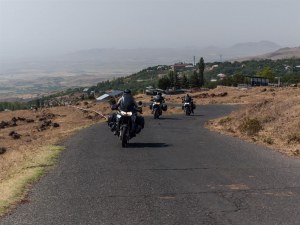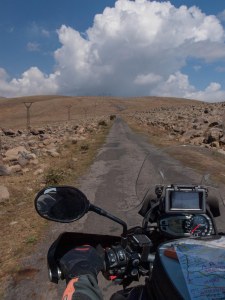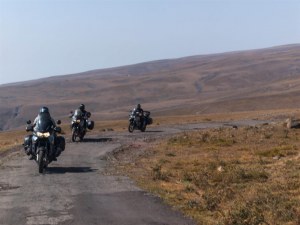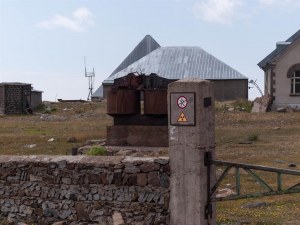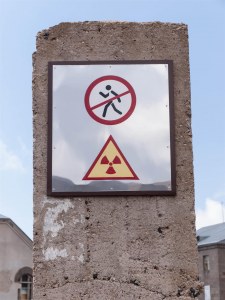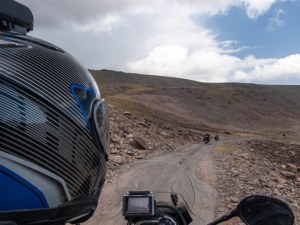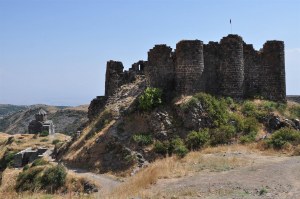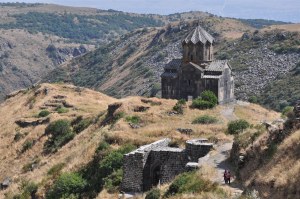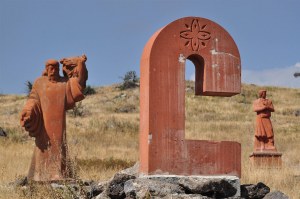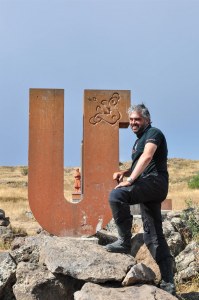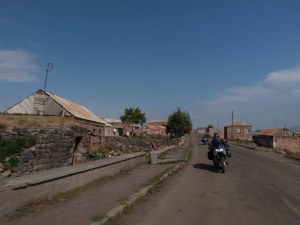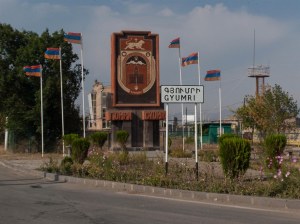From high to highest...
At 10 am we leave behind the capital and initially moving in the Ashtarak. At the intersection of Agarak, we turned right and followed a narrower uphill road, leaving behind us the highway (M1). As we were climbing, we acquired more and better views of the plateau on which is built the capital. Unfortunately, the atmosphere was cloudy and does not allowed us to see the whole of Yerevan, except of one part.
The route crosses the nice and tidy village of Byurakan, which hosts the homonymous observatory. Founded in 1946 by Viktor Hambardzumyan, was one of the main centers of astronomy of the former Soviet Union. In the past it had contributed in large astronomical discoveries, but with the fall of the USSR followed its decline. We continued in a helical path with fairly good quality road until the junction of fortress Amberd, while nearby is built the ancient church of Vahramashen. We decided to visit first the Kari lake and then to visit these two sites.
After the crossroad, the road narrows even more and the first puddles make their appearance. Riding was at low speed because of the road condition. Along the way we met some shepherd’s huts, like those that you can find in Mongolia. Some Armenians told us, that they are nomadic herders coming from Iran and Iraq.
The scenery was breathtaking and very alpine. We didn’t saw any trees around and as we gained altitude, cold became more profound. We reached appr 3200m and we were on a plateau that includes Kari Lake and some facilities. Most references I found online and here as well is located a weather station. But I read somewhere that it is a cosmic ray research station, which justifies the strange signs outside the premises.
Lake Kari (translation: stone lake) is located between the peaks of Mount Aragats and formed from melting snow of the surrounding mountains. The place is very popular at the locals and the climbers. At the top there is only one restaurant-hotel (Xashanots) which has shaped pavilions on the lakeshore. Although ordering proved to be a feat, we found out that the place is famous for its soup «khash». It is served on a plate where underneath it they adapt a bowl with hot water, which keeps it warm. The soup looks like tripe and contains meat from beef feet.
While the others could not resist the smell of nearby pavilions, Stelios continued the exploration to the opposite side of the lake and 100 meters higher where there is a large cross and around it the have built a large number of small stone towers. Stelios "builds" our small tower and he comes back to the restaurant where we have ordered all the local delicacies. Although we have a little hesitation about the quality, all the plates are more than wonderful.
The weather started to gather rain clouds. Thick black clouds coming towards us and loud sounds start sounding intermittently. It is time to depart, as it is not the best thing for us to start raining up here. With swift movements begun to descend enjoying once again the fantastic routing which brought us up here.
At the junction we found earlier climbing, we turned right towards the fortress Amberd, which is situated at the confluence of rivers Arkashen and Amberd, at an altitude of 2300m. The name of the castle in the Armenian language means "fortress in the clouds", but the original construction reason is not unambiguous. Some sources say it was a summer residence of the kings, who made various building interventions and additions and created what we see nowadays. Fortification property acquired only during the invasions of Seljuk Turks. At 1026 the church Astvatsatsin was built next to it, as originally called, or Vahramashen as it is known today.
The weather however seemed to follow us ... So after a quick tour initially depart towards the village Antarut. There we turn left following an almost deserted path towards the site that hosts the open-air museum of Literature of the Armenian alphabet. The point is right at the junction with the national network Artashavan - Alagyaz (M-3). The area was interesting for us, despite the fact that we do not know the Armenian language. We tried to understand and match each letter of the Armenian alphabet with the ones of the Latin alphabet. With the help of a book doing matching, which were confirmed by a local that sells souvenirs. In his shop he had wooden Armenian letters and he happily explains which one matches the other...
From there we took the road to Gyumri which is about 90km. We set course first to the north and then to the west, circling somehow the mountain Aragats. In its vertices has "stuck" the black cloud we saw when we were in Lake Kari. The route is spectacular. We rode on a plateau at an altitude of more than 2000m. Especially after the village Alagyaz, the landscape becomes more impressive, with the plateau being so great that it gives you the feeling that you are moving in a vast plain. Only the cold reminds us that we were at high altitude. The roads that we followed - most of them- are endless straights and only when started to approach Gyumri, begun to pass through villages, which might be poor but seems tidy.
Late in the afternoon we arrive in the city of Gyumri, which also has an airport, playing an important role in the region, as it serves with flights even residents of the neighbouring Georgia. The Gyumri is widely known among Armenians. They say that its history begins 5000 years back. The old name of the city was «Kumayri». It lies in the valley of Sirak, at the left bank of river Akhuryan. In ancient times, Kumayri-Gyumri was the commercial crossroads for different nations.
An earthquake that took place in 1988 destroyed much of the city. Many civilians were killed and those who survived began slowly to leave, so much where the city reached the limits of desolation. According to official figures, 3,500 families were left homeless by the earthquake. In recent years there is an effort of reconstruction. The city has a strong Russian influence and this can be found out from the remaining Soviet style -from earthquake, buildings, and the inscriptions of the shops which are in Russian. Generally, the city exudes a positive element, but without having something very impressive to show.
Entered the town, we stoped to refuel in a service station. The old man servant is very friendly and seems impressed by the fact that we have reached with the bikes up here ... maybe it’s his fist time to see this. He gets even more excited when he learns that we are Greeks. A similar behaviour has a group of young children playing nearby the hotel that we are thinking to stay at... At the moment they saw us they stopped playing and literally stick on us. Trying to communicate with their not so good English, which started and ended with the phrase: «My name is ...». Once the first child said it, all the others repeated it!
Now about the hotel, (Golden Apricot) is not what it seems or prefigures externally. The only positive is the young man who runs the place who is very polite, speaks very good English, and does his best to make our stay enjoyable. Otherwise it is expensive for the country data, the plumbing in the bathrooms smell and the mattress on the beds were not for tired bodies...
We walked to the main street -where our hotel lies as well- to the square of Peace where by diabolical coincidence all the Hotels of this road host wedding receptions. A crowd of well-dressed people were coming in and out from the hotels... Of course at our hotel as well there was madness...
In a supermarket Stratos and Natasha went inside to ask what time it closes, so that we can obtain some things returning at the hotel for our food, but also to get rid of the Armenian money before our departure from the country. The conversation was done with signs as English for locals is harder than Chinese. Showed the clock and making additional gestures, Stratos tried to ask them what the opening hours were... The result is the employee looking for watch batteries! At the following minutes all customers were involved to solve the puzzle and the solution was given from an Armenian that spoke English, friend of a customer that called him on the phone. When they do not understand exactly what we asked, all of them are laughing out loud!
We sat in Hatsatun restaurant in the central square, where the food turns out delicious and cheap. At the next table, listening to our conversations, a gentleman speaks in Greek. He is a Russo-Pontiac who was born in Georgia. He has grown up in Tbilisi and in recent years has moved to Moscow with his family. Because of the fact that there is a direct flight from Gyumri to Moscow, it works better for him to leave from the airport of this city for Russia than from Tbilisi. He asks us about our trip and he is very glad he had the opportunity to speak Greek... Leaving he tells us: "Who knows, we might meet again somewhere..."
At 10pm we returned to the hotel with mixed feelings. It was our last day in the beautiful Armenia... Tomorrow, we will pass -again- in Turkey through Georgia, in order to continue there the last part of our itinerary...

